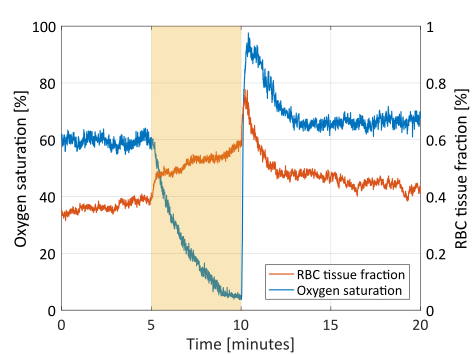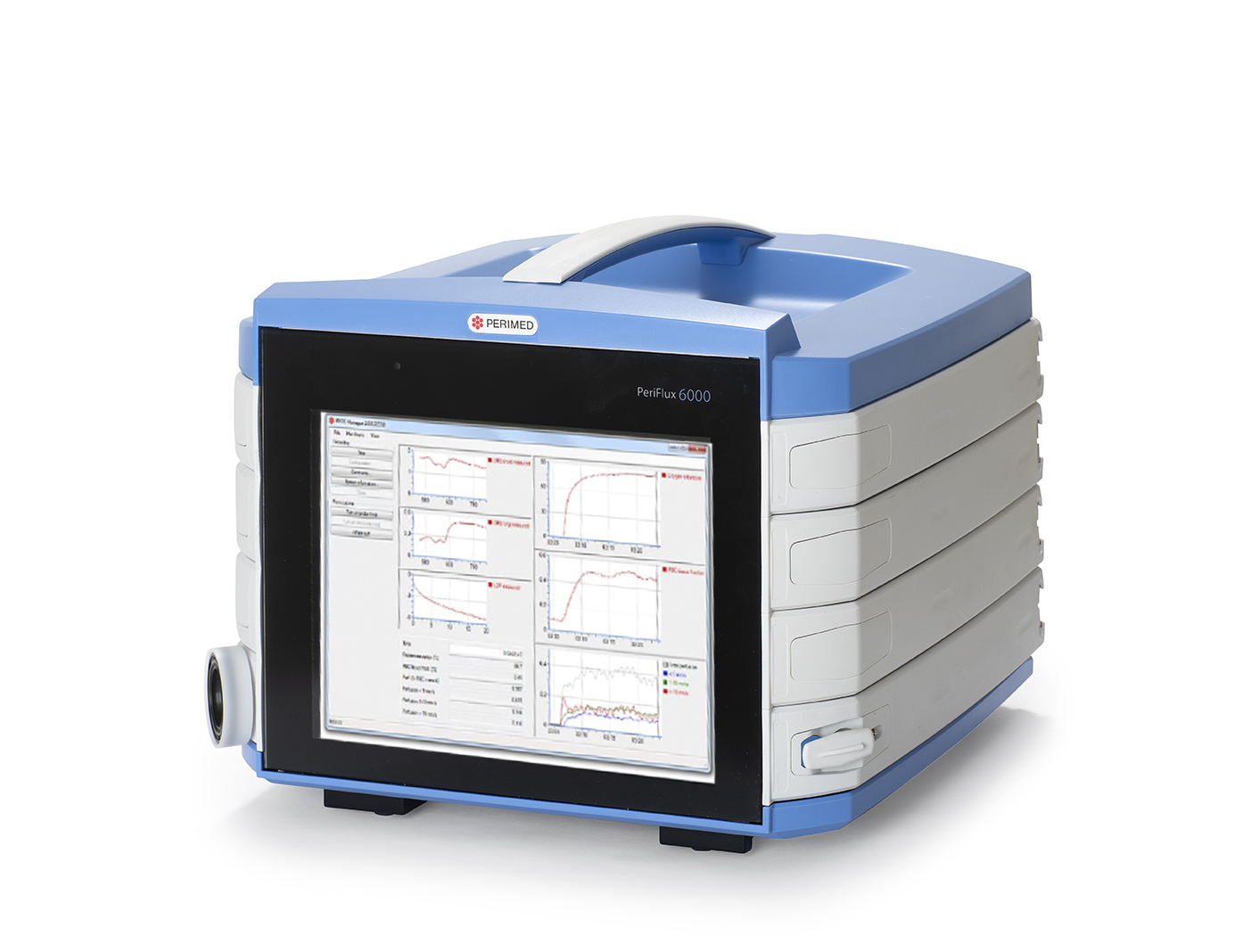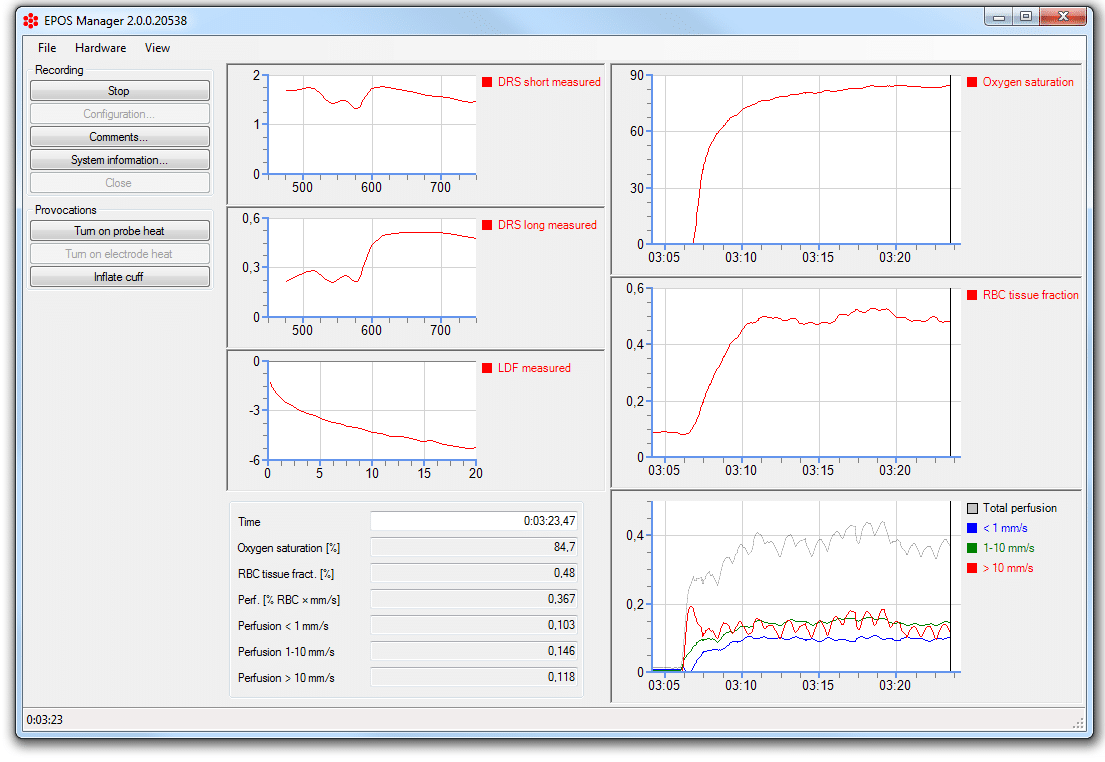PeriFlux 6000 EPOS
Enhanced Perfusion and Oxygen Saturation (EPOS).
Quantitative speed-resolved perfusion and oxygen saturation.
![]()
In the PeriFlux 6000 EPOS system, laser Doppler flowmetry (LDF) and diffuse reflectance spectroscopy (DRS) have been successfully integrated, enabling accurate measurements of blood flow and oxygen saturation in the microcirculation. This enables unexplored possibilities to study and understand complex disease progressions such as severe diabetes and other physiological events involving blood flow and oxygenation.
The principal advantage of this novel technology is that it presents blood perfusion in absolute units, not only qualitatively as when using a standard laser Doppler. Furthermore, it distinguishes different speeds within the blood flow—speed-resolved perfusion. For example, it enables the ability to differentiate slow nutritive flow, essential for all living cells in the body, from faster flow that only has the purpose of transportation. In addition, it is possible to study the correlation between flow speed and red blood cell (RBC) oxygen saturation, revealing information about oxygen delivery and uptake into the surrounding tissue. To estimate the microcirculatory parameters, a unique model-based analysis of multimodal measurements is employed. The multilayered tissue model is adapted to the measured signals in real time and the following parameters are obtained from the adapted model:
- RBC oxygen saturation (%)
- RBC tissue fraction: gram RBC / 100 gram tissue (%)
- Oxygenized and reduced hemoglobin tissue concentration (µM)
- Speed-resolved perfusion: gram RBC / 100 gram tissue × mm/seconds (% RBC × mm/second). Three different speed regions: < 1 mm/second, 1 to 10 mm/second, and > 10 mm/second
- Measurement depth (mm)
The figures show an example of the output parameters during a post-occlusive reactive hyperemia test on forearm skin.
The PeriFlux 6000 EPOS system consists of a main unit (PF 6002 EPOS Main Unit) equipped with a spectroscopy unit (PF 6060 Spectroscopy Unit) and a laser Doppler monitoring unit combined with temperature control (PF 6011 EPOS LDPM/Temp Unit). In addition, a dedicated fiber-optic probe (PROBE 650) that integrates the DRS and LDF modalities is required. The probe includes heating functionality. Furthermore, a pressure unit (PF 6050 Pressure Unit) can optionally be added to accurately study post-occlusive hyperemia responses, and a tcpO2 unit (PF 6040 tcpO2 Unit) can be added for simultaneous transcutaneous oxygen pressure recordings. A dedicated software (EPOS Manager) is available for operation and data evaluation.
References:
1.Machine learning for direct oxygen saturation and hemoglobin concentration assessment using diffuse reflectance spectroscopy. < https://doi.org/10.1117/1.JBO.25.11.112905> Fredriksson, I., Larsson, M., Strömberg, T. Journal of Biomedical Optics, 25(11), 2020
2.Inverse Monte Carlo in a multilayered tissue model: merging diffuse reflectance spectroscopy andlaser Doppler flowmetry. Fredriksson I, Burdakov O, Larsson M, Strömberg T. Journal of Biomedical Optics. 18(12), 2013.
3.Oxygen saturation, red blood cell tissue fraction and speed resolved perfusion – A new optical method for microcirculatoryassessment. Jonasson H, Fredriksson I, Pettersson A, Larsson M, Strömberg T. Microvascular Research. 102, 2015.
4.Skin microvascular endothelial dysfunction is associated with type 2 diabetes independently ofmicroalbuminuria and arterial stiffness. Jonasson H, Bergstrand S, et al. Diabetes and VascularDisease Research. 14(4), 2017.
5.The relationship between forearm skin speed-resolved perfusion and oxygen saturation, and finger arterial pulsationamplitudes, as indirect measures of endothelial function. Bergstrand S, Morales M-A, Coppini G, Larsson M, Strömberg T.Microcirculation. 25(2), 2018.
6.Validation of speed-resolved laser Doppler perfusion in a multimodal optical system using a blood-flow phantom. Jonasson H, Fredriksson I, Larsson M, Strömberg T, Journal of Biomedical Optics 24(9), 2019.
7.Normative data and the influence of age and sex on microcirculatory function in a middle-aged cohort: results from theSCAPIS study. Jonasson H, Bergstrand S, et al. American Journal of Physiology-Heart and Circulatory Physiology 318(4),2020.
Please fill in the form to get more information
Disclaimer: It is possible that the products on the Perimed website may not be cleared for sale in all markets.






